Bottle brush, Swamp Banksia, Tropical Banksia, Northern Banksia
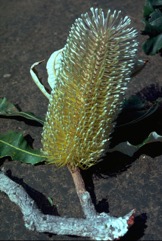
It is a tropical plant. It occurs in dry coastal areas. It is suited to warm areas in sandy acid soil. It often grows near the edges of swamps. It is drought and frost resistant. It can grow on poor soils. It suits hardiness zones 11-12.
Edible Portion
- Nectar
Where does Bottle brush grow?
Found in: Asia, Australia, Indonesia, Pacific, Papua New Guinea, PNG, SE Asia
Notes: There are about 75 Banksia species. They are mostly in Australia.
Status: A minor incidental food in Papua New Guinea.
Growing Bottle brush, Swamp Banksia, Tropical Banksia, Northern Banksia
Cultivation: Seeds grow easily. Young seedlings transplant easily. Under good conditions young plants grow rapidly.
Edible Uses: The flowers at the yellow stage are broken off and the sweet sap which drips out is collected and eaten. CAUTION Cribb in Wild Foods in Australia suggests headaches and nausea can result from sucking too much bottle brush sap.
Production: Flowers are produced irregularly throughout the year but with a main season in mid June.
Nutrition Info
per 100g edible portion| Edible Part | Energy (kcal) | Protein (g) | Iron (mg) | Vitamin A (ug) | Vitamin c (mg) | Zinc (mg) | % Water |
|---|---|---|---|---|---|---|---|
| Nectar | - | - | - | - | - | - |
Bottle brush, Swamp Banksia, Tropical Banksia, Northern Banksia Photos

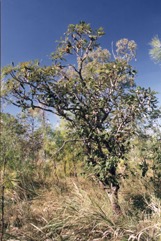
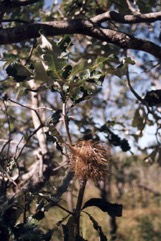
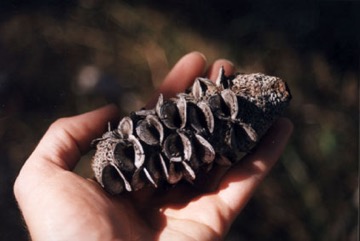
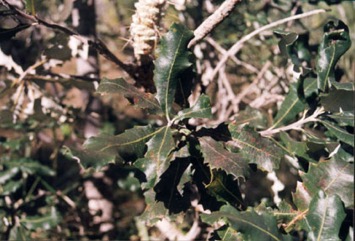
References
Barwick, M., 2004, Tropical and Subtropical Trees. A Worldwide Encyclopedic Guide. Thames and Hudson p 42
Bodkin, F., 1991, Encyclopedia Botanica. Cornstalk publishing, p 128
Brock, J., 1993, Native Plants of Northern Australia, Reed. p 95
Cronin, L., 1989, The Concise Australian Flora. Reed. p 164
Dunlop, C.R., Leach, G.J. & Cowie, I.D., 1995, Flora of the Darwin Region. Vol 2. Northern Territory Botanical Bulletin No 20. p 119
Elliot, W.R., & Jones, D.L., 1982, Encyclopedia of Australian Plants suitable for cultivation. Vol 2. Lothian. p 291
Etherington, K., & Imwold, D., (Eds), 2001, Botanica's Trees & Shrubs. The illustrated A-Z of over 8500 trees and shrubs. Random House, Australia. p 115
French, B.R., 1986, Food Plants of Papua New Guinea, Asia Pacific Science Foundation p 315
Hearne, D.A., & Rance, S.J., 1975, Trees for Darwin and Northern Australia. AGPS, Canberra p 29
Hibbert, M., 2002, The Aussie Plant Finder 2002, Florilegium. p 38
IRVINE,
Isaacs, J., 1987, Bush Food, Aboriginal Food and Herbal Medicine. Weldons. p 137
Lazarides, M. & Hince, B., 1993, Handbook of Economic Plants of Australia, CSIRO. p 30
Levitt, D., 1981, Plants and people. Aboriginal uses of plants on Groote Eylandt. Australian Institute of Aboriginal Studies, Canberra. p 117
Low, T., 1991, Wild Food Plants of Australia. Australian Nature FieldGuide, Angus & Robertson. p 142
Paczkowska, G . & Chapman, A.R., 2000, The Western Australian Flora. A Descriptive Catalogue. Western Australian Herbarium. p 466
Scarth-Johnson, V., 2000, National Treasures. Flowering Plants of Cooktown and Northern Australia. Vera Scarth-Johnson Gallery Association. Cooktown, Australia. p 74
Smith, K & I., 1999, Grow your own bushfoods. New Holland. Australia. p 108
Townsend, K., 1994, Across the Top. Gardening with Australian Plants in the tropics. Society for Growing Australian Plants, Townsville Branch Inc. p 96
Wheeler, J.R.(ed.), 1992, Flora of the Kimberley Region. CALM, Western Australian Herbarium, p 461
Wightman, G. & Brown, J., 1994, Jawoyn Plant Identikit, Common Useful Plants in the Katherine Area of Northern Australia. Concervation Commission Northern Territory. p 13
Yunupinu Banjgul, Laklak Yunupinu-Marika, et al. 1995, Rirratjinu Ethnobotany: Aboriginal Plant Use from Yirrkala, Arnhem Land, Australia. Northern Territory Botanical Bulletin No 21. Parks and Wildlife Commission of the Northern Territory. p 21.
IRVINE